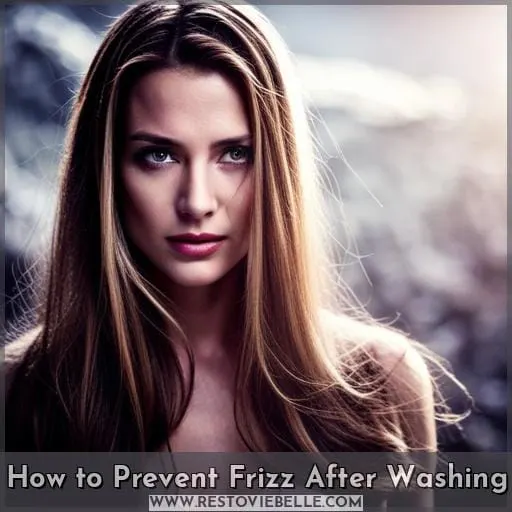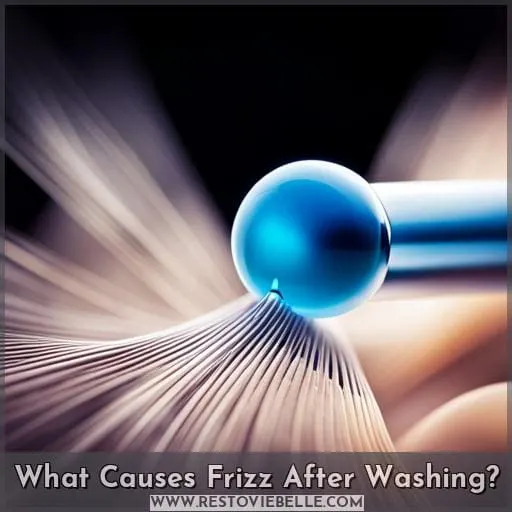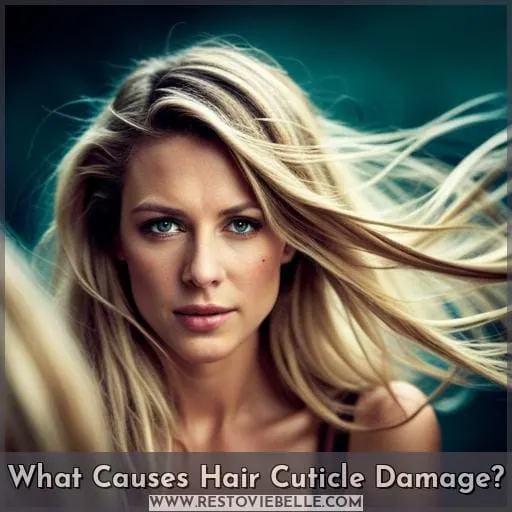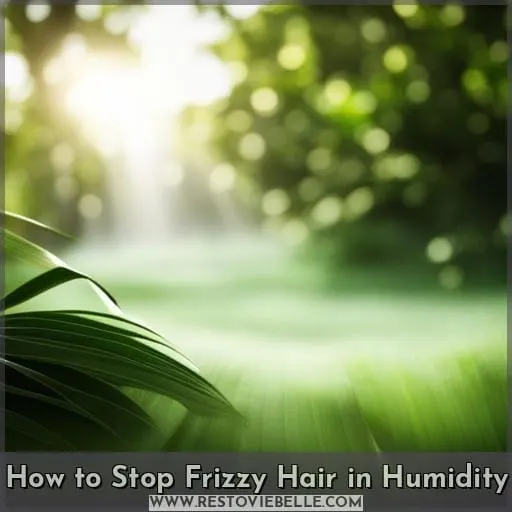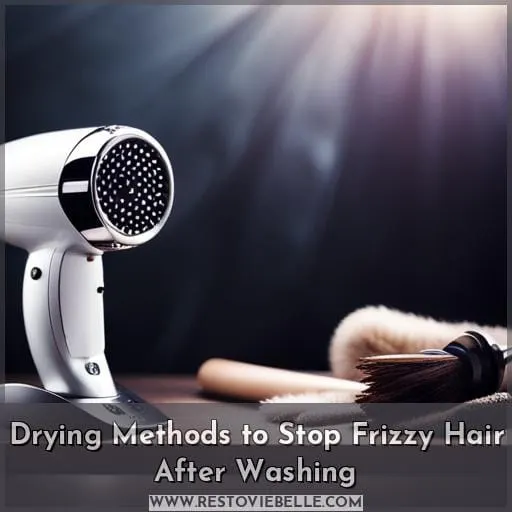This site is supported by our readers. We may earn a commission, at no cost to you, if you purchase through links.
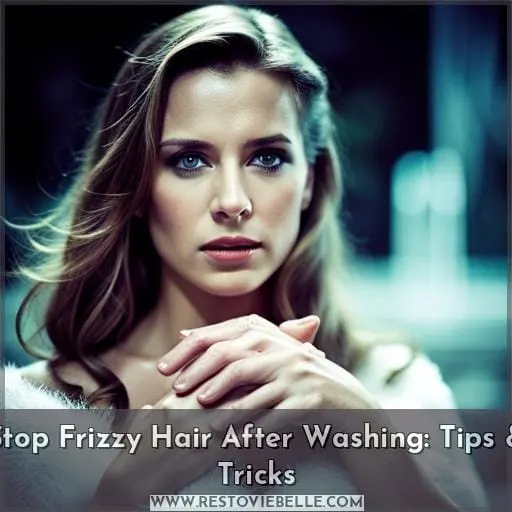 You wouldn’t believe it, but up to 65% of people struggle with frizzy hair after washing. We get it – that just-washed hair feeling doesn’t normally come with a poofy mess. But there’s good news: you can stop the frizz and keep your hair smooth with a few easy tricks.
You wouldn’t believe it, but up to 65% of people struggle with frizzy hair after washing. We get it – that just-washed hair feeling doesn’t normally come with a poofy mess. But there’s good news: you can stop the frizz and keep your hair smooth with a few easy tricks.
Let’s walk through simple solutions like rinsing with cold water, using the right hair products, and proper drying techniques. With some adjustments to your routine, you’ll have shiny, frizz-free locks in no time.
Table Of Contents
- Key Takeaways
- How to Prevent Frizz After Washing
- General Tips for Preventing Frizz
- What Causes Frizz After Washing?
- What Causes Hair Cuticle Damage?
- What Causes Frizz in Humidity?
- Which Hair Types Tend to Have Frizz?
- How to Stop Frizzy Hair After Washing
- How to Stop Frizzy Hair in Humidity
- What Types of Products Should You Try?
- Drying Methods to Stop Frizzy Hair After Washing
- Frequently Asked Questions (FAQs)
- Conclusion
Key Takeaways
- Cold water rinses and proper towel drying techniques can help prevent frizz after washing.
- Using styling products immediately after showering and opting for air-drying can minimize frizz.
- Avoiding heat styling and regularly trimming split ends are essential for healthier hair and reducing frizz.
- Using hair masks and treatments, such as avocado, coconut oil, honey, olive oil, and aloe vera, can improve hair health and tame frizz.
How to Prevent Frizz After Washing
When looking to stop frizzy hair after washing, focus on:
- Hair care recommendations
- Treatments
- Product choices
- Heat styling alternatives
Adjusting your hair washing and styling routine can make all the difference. Stay tuned as we offer tips across these areas to help you smoothen and define your strands.
Hair Care Recommendations
To prevent frizz after washing:
- Avoid heat styling
- Use leave-in conditioner
- Trim split ends regularly
- Opt for protective hairstyles
- Sleep on a silk pillowcase
- Brush hair gently with a wide-tooth comb between washes to minimize damage.
Using the right hair care and products nourishes locks and prevents frizz.
Hair Masques and Treatments
Frequently moisturize your hair by treating it with avocado hair masques to seal in moisture or jojoba oil weekly to prevent frizzy hair after washing.
Apply a coconut oil hair treatment before bed to deeply condition thick, curly hair.
Use honey as an intensive hair mask to smooth the cuticle and eliminate frizz.
Opt for an olive oil hair treatment to add shine.
Or make an aloe vera hair mask to hydrate hair and tame flyaways.
Styling Products to Use and Avoid
Use styling products that control frizz and enhance your hair’s natural texture for preventing frizz after washing.
Look for product ingredients like argan oil, shea butter, or coconut oil which help to moisturize and tame unruly strands.
Avoid products with alcohol as they can strip moisture from the hair.
Experiment with different application methods to find what works best for your hair type.
Heat Styling Cautions and Alternatives
If you need heat stylers for your hair, invest in an ionic hairdryer or diffuser to maintain smooth hair and avoid frizz after washing.
Ionic benefits reduce frizz and static electricity, leaving your locks silky and shiny.
Consider getting a shorter haircut for easier styling with less reliance on heat tools.
Use dry shampoo between washes to keep your style fresh without subjecting it to excessive heat.
General Tips for Preventing Frizz
When looking to stop frizzy hair after washing, there are some key things you can do right off the bat.
- Make sure to rinse hair with cold water.
- Gently dry with a t-shirt or microfiber cloth.
- Detangle strands while damp.
- Apply styling products immediately after showering.
- Let hair air-dry whenever possible.
Following these basic guidelines will help you prevent frizz and keep hair smooth.
Rinse With Cold Water
To prevent frizz after washing your hair, start by rinsing it with cold water.
Cold water helps to seal the hair cuticles and reduce frizz.
Incorporate other techniques like plopping or pineapple-ing for additional frizz-fighting benefits.
Consider your hair type when choosing styling products and avoid excessive heat styling.
| Cold Water Benefits | Frizz-Fighting Techniques |
|---|---|
| Seals Hair Cuticles | Plopping |
| Reduces Frizz | Pineapple-ing |
Dry With T-shirt or Microfiber Cloth
After washing your hair, you’ll want to gently blot excess moisture with a soft t-shirt or microfiber cloth instead of roughly drying with a towel.
- T-shirt
- Microfiber cloth
- Air-dry
Detangle While Damp
Detangle your hair while it’s still damp to prevent frizz.
Use a wide-tooth comb and gently work through any knots or tangles.
This will help distribute natural oils, reduce breakage, and minimize frizz.
Incorporating detangling techniques into your nighttime haircare routine can lead to smoother, more manageable hair in the morning.
Avoid heat styling and opt for heat-free drying methods to further protect against frizz.
Apply Styling Products
You’ll cut back on frizz by putting on styling products right after showering.
Here are some tips for applying styling products effectively:
- Use a dime-sized amount of product and distribute it evenly through your hair.
- Start from the ends and work your way up to avoid weighing down roots.
- Avoid applying too much product, as this can lead to greasiness or buildup.
- Choose products specifically designed to fight frizz and promote healthy hair.
Let Hair Air-Dry
You should often let your hair air-dry instead of blow-drying to prevent frizz.
Air drying has numerous benefits for your hair, such as:
- Reducing heat damage
- Maintaining moisture
You can also try:
- Overnight plopping
- Using silk pillowcases
to protect your hair while you sleep.
Additionally, incorporating protective hairstyles and following the curly girl method can help minimize frizz after washing.
What Causes Frizz After Washing?
Washing your hair can cause major frizz issues if you aren’t careful. Using hot water, rubbing hair vigorously with a towel, and skipping styling products can all lead to crazy flyaways and fuzz. Follow a few simple hair care rules after shampooing to keep your locks smooth and frizz-free.
Cold water rinse
To prevent frizz after washing your hair, start by incorporating a cold water rinse into your routine. Cold water has numerous benefits for your hair, including reducing frizz and adding shine.
- Cold Water Benefits:
- Washing with cold water helps to seal the cuticles of your hair strands, preventing moisture loss and reducing frizz.
- The chilly temperature of the water soothes any potential inflammation on the scalp that can lead to frizzy locks.
- Hydrotherapy for hair involves using cold temperatures to stimulate blood flow in the scalp and promote healthier follicles.
- A refreshing blast of icy-cold water at the end of your shower can help calm down unruly strands, leaving you with smoother and more manageable tresses.
Incorporating a cold-water rinse into your routine is an easy yet effective way to combat frizz after washing while providing some much-needed hydration and relief for stressed-out locks.
Proper towel drying
Transitioning from the cold rinse, pat-drying your locks with a microfiber towel or cotton t-shirt prevents additional friction damage after washing.
Gently plop hair in the towel, softly scrunching to absorb moisture rather than rubbing the strands.
This proper towel drying minimizes cuticle disruption, allowing hair masks and nourishing oils to better penetrate for long-lasting frizz protection between washes.
Embrace your texture with leave-in treatments and air dry for friction-free styling.
Use of styling products
Avoiding frizz after washing your hair can be achieved by using the right styling products.
When selecting products, it’s important to choose ones specifically formulated for controlling frizz and providing humidity defense. Look for ingredients like argan oil, shea butter, or glycerin that help seal in moisture and smooth down the cuticle.
Apply these products evenly through your damp hair using techniques like scrunching or raking with your fingers to ensure even distribution.
Additionally, consider using styling tools such as a diffuser attachment on your blow dryer or a wide-toothed comb to further control frizz and enhance definition.
What Causes Hair Cuticle Damage?
You should know that washing, styling, drying, and even daily wear and tear on hair can cause damage to the cuticle layer. Hot water, harsh chemical products, too much heat styling, over-washing, and rough towel drying after a shower will break down the cuticle and lead to frizz.
Learning to protect your hair from these causes of cuticle damage will allow healthier, smoother, less frizzy locks.
Hot Water
One cause of hair cuticle damage is washing your hair with hot water.
This lifts the protective cuticle layer, allowing moisture to escape and leading to frizz.
You’ll want to keep the temperature lukewarm to prevent lifting the cuticle and causing frizz after washing.
Stick to cooler showers, limit washing, and use conditioning products to keep hair smooth.
Hair Products
To prevent hair cuticle damage, you should be mindful of the hair products that you use.
- Seek reviews before purchasing new products.
- DIY masks with natural ingredients are gentler than store-bought.
- Consult with stylists on best practices for your hair type and seasonal care.
Heat Styling
After using styling products, be cautious with heat tools because they can damage the hair cuticle and cause frizz.
Invest in an ionic hairdryer or diffuser for heat styling. Ionic dryers reduce frizz by breaking up water molecules, while diffusers help enhance natural curls without causing damage.
Hair Washing Frequency
If you wash your hair too frequently, it can cause damage to the hair cuticle. To prevent this, follow these tips:
- Limit washing frequency to preserve natural oils.
- Use moisturizing and sealing masques.
- Be cautious of styling product pitfalls that may strip moisture from your hair.
Hair Drying
Properly drying your hair is essential to prevent damage to the hair cuticle. Using towel techniques, overnight care, and styling essentials can help you achieve frizz-free nights and embrace your natural texture.
Towel Techniques
- Use a microfiber towel or cotton t-shirt instead of a regular towel
- Gently squeeze excess water from your hair using the cloth
Overnight Care
- Sleep on a silk pillowcase
- Protect your strands with loose braids or pineapple-ing before bed
Styling Essentials
- Apply anti-frizz serums or creams
- Use heat protectant sprays when using heat tools
By implementing these simple tips into your routine, you can minimize frizz and maintain healthier-looking locks.
What Causes Frizz in Humidity?
Humidity is a common culprit for frizzy hair, as moisture in the air can penetrate the hair shaft and disrupt its structure. This leads to the dreaded frizz that many people experience after washing their hair.
Understanding how humidity affects your locks and taking steps to prevent or manage frizz can help you maintain smooth, sleek strands even in humid conditions.
Humidity and frizz
When humidity levels rise, the excess moisture in the air can cause frizz to become more prominent and difficult to manage. Humidity and styling are often a challenging combination for those battling frizz.
To combat this, it’s important to use weather-resistant haircare products that are designed specifically for humid conditions.
Look for humidity-proof hairstyles that will keep your hair frizz-free on even the most humid days.
By taking these steps, you can minimize the effects of humidity on your hair and maintain smooth locks all day long.
Preventing frizz in humidity
To prevent frizz in humidity, you can take steps to protect your hair from the moisture in the air. Humidity is a common culprit for causing frizz, as it disrupts the natural structure of your hair and causes it to swell.
To fight against this, opt for hairstyles that keep your hair off your face and neck, such as braids or buns. Use free styling techniques like scrunching or twisting instead of brushing through wet hair to minimize friction and potential frizz.
Additionally, invest in anti-frizz products that are specifically designed to combat humidity and create a barrier on your strands.
Incorporating these tips into a weather-resistant hairstyling routine will help ensure that you have smooth and manageable locks no matter how humid it gets outside.
Managing frizz after washing
You’ll struggle with controlling your hair’s frizz when humidity causes the cuticle to swell and hair to expand.
Strategic product application after washing,
Cold water benefits for closing the cuticle,
Insights on how hair types uniquely battle humidity’s swelling effects,
And preferred drying techniques that limit damage can make all the difference in managing frizz.
Implementing small adjustments informed by your hair type’s climate challenges and hydration needs reduces frizz over time through consistent care.
Which Hair Types Tend to Have Frizz?
Whether you have curly, wavy, straight or chemically-treated hair, you likely experience some frizz from time to time.
Hair textures with kinks or waves are most prone to frizzing up, as the strands naturally resist laying flat.
Even sleek, straight hair can get frazzled, especially with heat styling damage or in humid weather.
Curly Hair
If you have curly hair, you may be more prone to frizz.
To maintain curl definition and moisture balance, practice nighttime care by:
- Protecting curls in a loose pineapple
- Wrapping hair in a silk scarf
When styling, opt for frizz-fighting products with natural oils that enhance curl pattern instead of weighing hair down.
Embrace techniques like squish-to-condish, plopping, and finger coiling to encourage coil formation.
Wavy Hair
Wavy hair is prone to frizz, especially in humid weather. To combat this, follow these tips for wavy hair styling:
- Enhance curl definition with the right products.
- Use humidity defense sprays or serums to protect against frizz.
- Incorporate weekly treatments and cuticle care into your routine for healthier, more manageable waves.
Straight Hair
Straight hair is another hair type that tends to have frizz.
To achieve sleek and smooth locks, straight-haired individuals can benefit from various styling techniques.
Using a flat iron with proper technique can help eliminate frizz and create a polished look.
Additionally, incorporating shine-boosting tips and opting for frizz-free blowouts can further enhance the overall appearance of straight hair.
Chemically-treated Hair
Chemically-treated hair is prone to frizz, so it’s important to take extra care in preventing and managing frizzy hair after washing.
Chemical treatments, such as perms or relaxers, can strip the hair of its natural moisture and disrupt the cuticle layer.
To combat frizz, opt for color protection products and deep conditioning treatments specifically designed for chemically-treated hair.
Proper dye maintenance is also crucial in maintaining smoothness and reducing frizz.
How to Stop Frizzy Hair After Washing
To stop frizzy hair after washing, there are a few key techniques you can try:
First, consider washing your hair in cold water as it helps to seal the cuticle and prevent frizz.
Additionally, limiting the frequency of hair washing can help retain natural oils that keep your strands hydrated and less prone to frizz.
When choosing products for your wash routine, opt for a conditioning shampoo that will nourish and moisturize your locks.
Finally, using a wide-tooth comb instead of a brush when detangling wet hair can minimize breakage and reduce frizz caused by friction.
Wash in Cold Water
To stop frizzy hair after washing, one of the key tips is to wash your hair in cold water.
Cold water benefits your hair by sealing the cuticles and preventing moisture loss, resulting in smoother and less frizzy strands.
Free rinsing with chilled water helps maintain healthy, hydrated locks and enhances the effectiveness of your other anti-frizz methods.
So turn down that shower temperature for some cool shower advantages!
Limit Hair Washing
To limit frizz after washing your hair, avoid washing it every day.
Over-washing can strip the natural oils from your scalp, leading to dryness and frizz.
Instead, try limiting wash frequency to maintain scalp health and moisture balance.
Incorporating dry shampoo benefits or exploring the No-Poo method can also help reduce frizz caused by excessive hair washing.
Additionally, consider the impact of water temperature on your hair’s condition when deciding how often to wash it.
Choose a Conditioning Shampoo
When it comes to preventing frizzy hair after washing, one important step is to choose a conditioning shampoo that will help keep your locks moisturized and smooth.
- Look for shampoos specifically designed for moisturizing hair care.
- Consider shampoos with ingredients like argan oil or shea butter.
- Avoid shampoos that contain sulfates, as they can strip moisture from the hair.
Use a Wide-Tooth Comb
Although a normal comb can snag and pull curly hair leading to frizz, when you’re washing your hair, be sure to use a wide-toothed comb so you don’t cause additional frizz. Wide-tooth combs are gentle on the hair and help detangle without causing breakage or damage.
| Comb Selection | Detangling Techniques |
|---|---|
| Use a wide-tooth comb for gentle detangling | Start from the ends of your curls |
| Avoid fine-tooth combs that can cause breakage | Work your way up slowly with each stroke |
Using a wide-tooth comb allows you to work through tangles in wet or damp hair without causing unnecessary friction. This helps minimize frizz by keeping the cuticle layer smooth and intact. When using the wide teeth of this type of comb, it’s important to start at the ends of your curls and work your way up slowly with each stroke, gently separating any knots along the way.
By selecting an appropriate tool like a wide-toothed comb during washing or styling sessions, individuals with curly or wavy locks can effectively prevent additional frizziness while maintaining healthier-looking strands overall.
How to Stop Frizzy Hair in Humidity
When humidity wreaks havoc on your hair, fight back by working with your texture instead of against it.
Seal in moisture and smooth flyaways by applying coconut oil to damp strands before heading outside.
If frizz persists, consider getting a keratin treatment to help tame unruly locks in muggy weather.
Keep Your Natural Hair Texture
After covering how to stop frizzy hair after washing, you’re onto keeping your hair’s natural texture to prevent frizz in humidity.
Embrace your texture through hydration hacks and natural curl care styling techniques.
Skip the blow dryer and heat tools that can disturb and frizz up your locks.
Allow your hair to air dry or pineapple it to encourage your natural pattern.
With the right frizz-free styles, you can flaunt your beautiful natural texture, no matter the humidity.
Use Coconut Oil
To combat frizzy hair in humid conditions, apply a small amount of coconut oil to your locks.
Try using it as an overnight treatment by warming a tablespoon of the oil, massaging into damp hair, covering with a shower cap, and rinsing out in the morning for extra conditioning power.
You can also mix coconut oil with ingredients like honey or avocado for customized DIY hair recipes that provide nutrients to boost shine and cut down on frizz.
Try a Keratin Treatment
To combat frizzy hair in humidity, try using a keratin treatment for smoother and more manageable locks.
Keratin benefits include sealing the hair cuticle to prevent frizz and boost shine.
- Research application techniques and choose salon vs at-home options based on cost and convenience.
- Understand long-term effects like loss of curl pattern.
- Follow maintenance tips between treatments like limiting washing and using sulfate-free shampoos.
What Types of Products Should You Try?
When looking to tame frizz after washing, focus first on hair serums and masks.
These products seal in moisture and smooth the hair cuticle to eliminate flyaways.
Try a weekly nourishing hair mask followed by a anti-frizz serum to help hair stay sleek between washes.
Hair Serums
You can use hair serums after washing to smooth down the cuticle and prevent frizz.
Look for lightweight, non-greasy formulas containing frizz-fighting oils like argan, coconut, or marula when choosing a serum.
Apply a small amount to towel-dried hair, concentrating on the mid-lengths and ends.
Serums seal in moisture, provide heat protection, add shine, and make hair more manageable.
For best results, massage serum through damp hair before blow drying or heat styling.
Reapply serum to tame flyaways or frizz throughout the day as needed.
Hair Masks
When tackling frizz after washing, give your locks an intense moisture treatment by slathering on a hair mask made with nourishing oils.
Hair masks are an excellent way to deeply hydrate and nourish your hair, helping to combat frizz and restore shine. Look for masks that contain ingredients such as avocado oil or jojoba oil, which provide numerous benefits for the hair including deep hydration and improved elasticity.
These masks can be applied once a week or as needed depending on the level of dryness in your hair. Incorporating this step into your routine will leave you with smoother, more manageable tresses that are less prone to frizz.
Hair masks are specifically formulated treatments designed to provide deep conditioning and hydration to the hair strands. They work by penetrating the cuticle layer of each strand, delivering essential nutrients and moisture directly where it’s needed most.
Avocado is one beneficial ingredient commonly found in many effective hair mask products due its high content of healthy fats like omega-3 fatty acids which helps moisturize dry scalp preventing dandruff whilst maintaining overall scalp health – ultimately promoting healthier looking locks from root-to-tip! Jojoba oil is another popular choice thanks mainly because it mimics natural sebum produced naturally within our own skin cells; thus providing similar protective properties making them perfect candidates when choosing what type(s) may best suit individual needs!
Other methods worth mentioning include cold water rinses (which help seal cuticles), using silk pillowcases (to reduce friction), utilizing ionic blowdryers (for reduced static electricity), all contribute significantly towards minimizing unwanted flyaways & breakage throughout time between washings!
Drying Methods to Stop Frizzy Hair After Washing
To stop frizzy hair after washing, there are several drying methods you can try.
One option is to use an Ionic Hair Dryer, which helps reduce frizz by emitting negative ions that counteract static electricity.
Another method is to gently dry your hair using a Microfiber Towel or a soft cotton T-Shirt instead of a rough terry towel.
Additionally, letting your hair air dry can also help prevent frizz by minimizing heat exposure and allowing your natural texture to form without disturbance.
Use an Ionic Hair Dryer
Now, let’s delve into the topic of drying methods to stop frizzy hair after washing by exploring the use of an ionic hair dryer.
Ionic hair dryers work by emitting negative ions that help break down water molecules on your strands, resulting in faster drying time and reduced frizz.
These dryers are highly recommended for those with frizzy or damaged hair as they can minimize static and flyaways.
Compared to regular hair dryers, ionic ones are less likely to cause damage due to their gentle heat distribution.
However, it’s important to note that using an ionic dryer alone may not completely eliminate all frizz – incorporating other techniques like applying anti-frizz products or using a diffuser attachment can provide even better results according to some users’ reviews.
Ionic Hair Dryer: An Overview
An ionic hair dryer is designed with advanced technology that emits negatively charged ions during the blow-drying process.
How It Works:
- Negative Ions: The emitted negative ions neutralize positive charges in water droplets on your wet strands.
- Faster Drying Time: By breaking down water molecules more efficiently than traditional dryers do (which rely solely on heat), an ionic dryer dries your moisture-laden locks quicker.
Benefits:
- Reduced Frizz & Static: The negative ions smooth out cuticles along each strand’s surface while minimizing static electricity buildup.
- Shine Enhancement: By sealing cuticles effectively through ionization, these blow-dry tools promote shine and glossy finish for healthier-looking tresses overall compared with conventional models lacking similar features.
- Gentle Heat Distribution & Damage Prevention*: Ionic technology helps distribute heat evenly across your mane when used correctly without overheating specific areas excessively— meaning fewer hot spots where potential harm could occur over long-term usage periods if not mindful about safety precautions such as employing suitable protectants before styling sessions commence!
- Quieter Operation**: Ionic dryers tend to produce less noise than traditional models, providing a more peaceful drying experience.
- Shorter Drying Time: The efficient water evaporation process facilitated by negative ions allows for quicker blow-dry sessions overall – great news if you’re always in a rush!
Ionic Hair Dryer vs. Regular Hair Dryer:
- Heat Distribution: Traditional hair dryers rely solely on hot air circulation for drying; ionic ones use both heat and negatively charged ions.
- Frizz Control: While regular hair dryers may still get the job done, users often report better frizz control with ionic options due to their ability to smooth cuticles effectively during the drying process. This can result in shinier strands that are less prone to flyaways or static electricity buildup over time.
- Damage Prevention*: Ionic technology helps distribute heat evenly across your mane when used correctly without overheating specific areas excessively— meaning fewer hot spots where potential harm could occur over long-term usage periods if not mindful about safety precautions such as employing suitable protectants before styling sessions commence!
- Noise Level**: Some individuals find that ionic hairdryers operate quieter compared with conventional models thanks partly (but not exclusively!) because they typically have multiple speed/heat settings available instead of one fixed setting found on many non-ionic counterparts too.
Potential Damage from an Ionic Hair Dryer:
While an ionic dryer is generally considered safe and gentle on most hair types when used properly, excessive heat exposure can lead to damage similar risks posed by other high-temperature beauty tools like curling irons or straighteners. To minimize any potential harm caused:
- Adjust temperature settings accordingly based upon individual needs/preferences rather than relying solely upon maximum power outputs suggested within manufacturer guidelines;
- Employ appropriate thermal protection products before using heated styling appliances;
- Limit prolonged direct contact between scalp/skin surfaces near treated follicles during operation timespan.
Ionic Hair Dryer vs. Diffuser:
An ionic hair dryer and a diffuser attachment can work together to combat frizz effectively, especially for those with curly or wavy hair types.
- Ionic Hair Dryer: An ionic dryer emits negatively charged ions to reduce static electricity and smooth the cuticles on your strands, ultimately reducing frizz.
- Diffuser Attachment: A diffuser is an attachment that disperses airflow more evenly, helping to enhance natural curls or waves while minimizing frizz caused by excessive heat. It also helps distribute the heat from the blow-dryer more gently across your head.
To achieve optimal results in managing frizzy hair after washing, consider using both an ionic hair dryer and a diffuser attachment during styling sessions.
Remember that everyone’s experience may differ when it comes to choosing between these two tools – some people may prefer one over the other based on personal preferences or specific hairstyling needs.
In conclusion, incorporating an ionic hair dryer into your drying routine can be beneficial in reducing frizziness after washing.
Use a Microfiber Towel or Cotton T-Shirt
Start by gently drying your hair with a microfiber towel or cotton t-shirt to prevent frizz after washing. These fabric types are gentle on the hair and help absorb excess moisture without causing friction or damage.
Here’s why these options are beneficial:
- Cotton benefits: Cotton t-shirts are soft and absorbent, making them perfect for drying delicate strands.
- Microfiber pros: Microfiber towels have finer fibers that can effectively wick away water from the hair, reducing frizz.
- Towel alternatives: Using these alternatives instead of regular bath towels minimizes roughness and friction that can lead to unwanted frizz.
By incorporating either a microfiber towel or cotton t-shirt into your post-wash routine, you’ll be able to maintain smoother locks and keep frizzy hair at bay.
Let It Air Dry
To prevent frizz after washing your hair, let it air dry instead of using heat styling tools.
Air drying is a great way to enhance your natural texture and avoid the damaging effects of excessive heat.
After washing your hair at night, simply wrap it in a microfiber towel or cotton t-shirt to absorb excess moisture without causing friction or frizz.
In the morning, you’ll wake up with beautifully dried hair ready for your friendly hairstyles and morning hair routine.
Frequently Asked Questions (FAQs)
How often should you trim your hair to prevent frizz?
To prevent frizz, it’s recommended to trim your hair every 8-12 weeks.
Regular trims help get rid of split ends and keep your hair healthy, reducing the chances of frizziness and promoting smoother strands.
What ingredients in shampoos and conditioners cause frizz?
Unfortunately, many common shampoo and conditioner ingredients like sulfates, alcohols, and silicones can cause frizz by stripping hair of natural oils and moisture.
I’d suggest trying sulfate-free, non-drying formulas with nourishing ingredients like oils and butters to help smooth and define curls.
How do I choose the right anti-frizz products for my hair type?
To choose the right anti-frizz products for your hair type, consider:
- Ingredients like argan oil or shea butter for thick and coarse hair.
- Lightweight serums or sprays with silicone-free formulas for fine or oily hair.
Experiment to find what works best for you.
What temperature should I set my hair dryer to minimize frizz?
To minimize frizz, set your hair dryer to a cool or medium heat.
Avoid the scorching flames of high temperatures that can singe and frazzle your strands, leaving them in disarray.
Keep it cool for smooth results.
Are silk pillowcases better for preventing frizz overnight?
Yes, a silk pillowcase is better for preventing frizz overnight.
The smooth fabric minimizes friction and allows you to slide your hair across it without disturbing the cuticle.
Choose 100% mulberry silk for best results.
Conclusion
Ultimately, preventing and managing frizz requires adjusting your hair care routine.
Washing, conditioning, drying, and styling with frizz-fighting techniques will transform your hair.
Implement cold water rinses, microfiber towels, hydrating masques, and anti-frizz serums.
You’ll soon discover the power of customized products and methods to keep your hair smooth, soft and frizz-free after every wash, however you style it.

